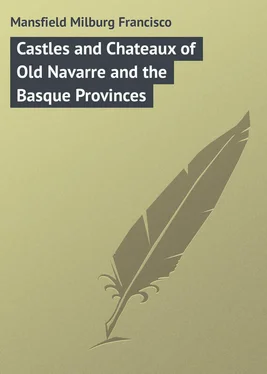Milburg Mansfield - Castles and Chateaux of Old Navarre and the Basque Provinces
Здесь есть возможность читать онлайн «Milburg Mansfield - Castles and Chateaux of Old Navarre and the Basque Provinces» — ознакомительный отрывок электронной книги совершенно бесплатно, а после прочтения отрывка купить полную версию. В некоторых случаях можно слушать аудио, скачать через торрент в формате fb2 и присутствует краткое содержание. ISBN: , Жанр: foreign_prose, на английском языке. Описание произведения, (предисловие) а так же отзывы посетителей доступны на портале библиотеки ЛибКат.
- Название:Castles and Chateaux of Old Navarre and the Basque Provinces
- Автор:
- Жанр:
- Год:неизвестен
- ISBN:http://www.gutenberg.org/ebooks/43609
- Рейтинг книги:4 / 5. Голосов: 1
-
Избранное:Добавить в избранное
- Отзывы:
-
Ваша оценка:
- 80
- 1
- 2
- 3
- 4
- 5
Castles and Chateaux of Old Navarre and the Basque Provinces: краткое содержание, описание и аннотация
Предлагаем к чтению аннотацию, описание, краткое содержание или предисловие (зависит от того, что написал сам автор книги «Castles and Chateaux of Old Navarre and the Basque Provinces»). Если вы не нашли необходимую информацию о книге — напишите в комментариях, мы постараемся отыскать её.
Castles and Chateaux of Old Navarre and the Basque Provinces — читать онлайн ознакомительный отрывок
Ниже представлен текст книги, разбитый по страницам. Система сохранения места последней прочитанной страницы, позволяет с удобством читать онлайн бесплатно книгу «Castles and Chateaux of Old Navarre and the Basque Provinces», без необходимости каждый раз заново искать на чём Вы остановились. Поставьте закладку, и сможете в любой момент перейти на страницу, на которой закончили чтение.
Интервал:
Закладка:
“ Armoiries de Concession ,” given for services by a sovereign prince – such as the armoiries belonging to Jeanne d’Arc.
“ Armoiries de Patronage ,” in reality quarterings added to an armoirie already existing. These were frequently additions to the blazonings of families or cities. Paris took on the arms of the King of France, the insistent Louis, by this right.
“ Armoiries de Dignité ,” showing the distinction or dignities with which a person was endowed, and which were added to existing family arms.
“ Armoiries de Famille ,” as their name indicates, distinguishing one noble family from another. This class was further divided into three others, “ Substituées ,” “ Succession ,” or “ Alliance ,” terms which explain themselves.
“ Armoiries de Communauté ,” distinctions given to noble chapters of military bodies, corporations, societies and the like.
Finally there was a class which belonged to warriors alone.
At all times illustrious soldiers adopted a devise , or symbol, which they caused to be painted on their shields. These were only considered as armoiries when they were inherited by one who had followed in the footsteps of his ancestors. This usage dates from the end of the ninth century, and it is from this period that armoiries , properly called, came into being.
The banners of the feudal sovereigns were, many of them, very splendid affairs, often bearing all their arms and quarterings. They were borne wherever their owners went, – in war, to the capital, and at their country houses. At all ceremonious functions the banners were ever near the persons of their sovereigns as a sign of suzerainty. The owner of a banner would often have it cut out of metal and placed on the gables of his house as a weather-vane, a custom which, in its adapted form, has endured through the ages to this day. In tournaments, the nobles had their banners attached to their lances, and made therewith always the sign of the cross before commencing their passes. Also their banners or banderoles were hung from the trumpets of the heralds of their house.
Another variety of feudal standard, differing from either the bannière or the pennon , was the gonfanon . This was borne only by bacheliers , vassals of an overlord.
“N’i a riche hom ni baron
Qui n’ait lès lui son gonfanon.”
The feudal banner, the house flag of the feudal seigneurs, and borne by them in battle, was less splendid than the bannière royale , which was hung from a window balcony to mark a kingly lodging-place. It was in fact only a small square of stuff hanging from a transversal baton. This distinguished, in France, a certain grade of knights known as chevaliers-bannerets . These chevaliers had the privilege of exercising certain rights that other knights did not possess.
To be created chevalier-banneret one had to be twenty-one years of age. If a chevalier was already a bachelier , a grade inferior to that of a banneret , to become a full blown chevalier he had only to cut the points from his standard – a pennon – when it and he became a banneret ; that is to say, he had the right to carry a banner, or to possess a fief de bannière .
There were three classes of fiefs in feudal France. First; the fief de bannière , which could furnish twenty-five combatants under a banner or flag of their own. Second; the fief de haubert , which could furnish a well-mounted horseman fully armed, accompanied by two or three varlets or valets . Third; the fief de simple écuyer , whose sole offering was a single vassal, lightly armed.
There was, too, a class of nobles without estates. They were known as seigneurs of a fief en l’air , or a fief volant , much like many courtesy titles so freely handed around to-day in some monarchies.
A vassal was a dweller in a fief under the control of the seigneur. The word comes from the ancient Frankish gessell .
The chevaliers, not the highest of noble ranks, but a fine title of distinction nevertheless, bore one of four prefixes, don , sire , messire , or monseigneur . They could eat at the same table with the monarch, and they alone had the right to bear a banner-lance in warfare, or wear a double coat of mail.
In 1481, Louis XI began to abolish the bow and the lance in France, in so far as they applied to effective warfare. The first fire-arms had already appeared a century before, and though the coulevrines and canons à main were hardly efficient weapons, when compared with those of to-day, they were far more effective than the bow and arrow at a distance, or the javelin, the pike and the lance near at hand. Then developed the arquebuse , literally a hand-cannon, clumsy and none too sure of aim, but a fearful death-dealer if it happened to hit.
The feudal lords, the seigneurs and other nobles, had the right of levying taxes upon their followers. These taxes, or impôts , took varying forms; such as the obligation to grind their corn at the mills of the seigneur, paying a heavy proportion of the product therefor; to press their grapes at his wine-press, and bake their bread in his ovens. At Montauban, in the Garonne, one of these old seigneurial flour mills may still be seen. The seigneurs were not ostensibly “in trade,” but their control of the little affairs of the butcher, the baker, and the candlestick-maker virtually made them so.
More definite taxes – demanded in cash when the peasants could pay, otherwise in kind – were the seigneurial taxes on fires; on the right of trade (the sale of wine, bread or meat); the vingtaine , whereby the peasant gave up a twentieth of his produce to the seigneur; and such oddities as a tax on the first kiss of the newly married; bardage, a sort of turnpike road duty for the privilege of singing certain songs; and on all manner of foolish fancies.
After the taxation by the seigneurs there came that by the clerics, who claimed their “ecclesiastical tenth,” a tax which was levied in France just previous to the Revolution with more severity, even, than in Italy.
Finally the people rose, and the French peasants delivered themselves all over the land to a riot of evil, as much an unlicensed tyranny as was the oppression of their feudal lords. One may thus realize the means which planted feudal France with great fortresses, châteaux and country houses, and the motives which caused their destruction to so large an extent.
It was the tyranny of the master and the cruelty of the servant that finally culminated in the Revolution. Not only the petty seigneurs had been the oppressors, but the Crown, represented by the figurehead of the Bourbon king in his capital, put the pressure on the peasant folk still harder by releasing it on the nobles. The tax on the people, that great, vague, non-moving mass of the population, has ever produced the greatest revenue in France, as, presumably, it has elsewhere. In the days before the Revolution it was le peuple who paid, and it was the people who paid the enormous Franco-German war indemnity in 1871.
The feudality in France, in its oppressive sense, died long years before the Revolution, but the aristocracy still lives in spite of the efforts of the Assembly to crush it – the Assembly and the mob who sang:
“Ah! ça ira, ça ira, ça ira,
Les aristocrates à la lanterne!
Ah! ça ira, ça ira, ça ira,
Les aristocrates on les pendra!”
And the French noblesse of to-day, the proud old French aristocracy, is not, on the whole, as bad as it has frequently been painted. They may, in the majority, be royalists, may be even Bonapartists, or Orléanists, instead of republicans, but surely there’s no harm in that in these days when certain political parties look upon socialists as anarchists and free-traders as communists.
Читать дальшеИнтервал:
Закладка:
Похожие книги на «Castles and Chateaux of Old Navarre and the Basque Provinces»
Представляем Вашему вниманию похожие книги на «Castles and Chateaux of Old Navarre and the Basque Provinces» списком для выбора. Мы отобрали схожую по названию и смыслу литературу в надежде предоставить читателям больше вариантов отыскать новые, интересные, ещё непрочитанные произведения.
Обсуждение, отзывы о книге «Castles and Chateaux of Old Navarre and the Basque Provinces» и просто собственные мнения читателей. Оставьте ваши комментарии, напишите, что Вы думаете о произведении, его смысле или главных героях. Укажите что конкретно понравилось, а что нет, и почему Вы так считаете.












